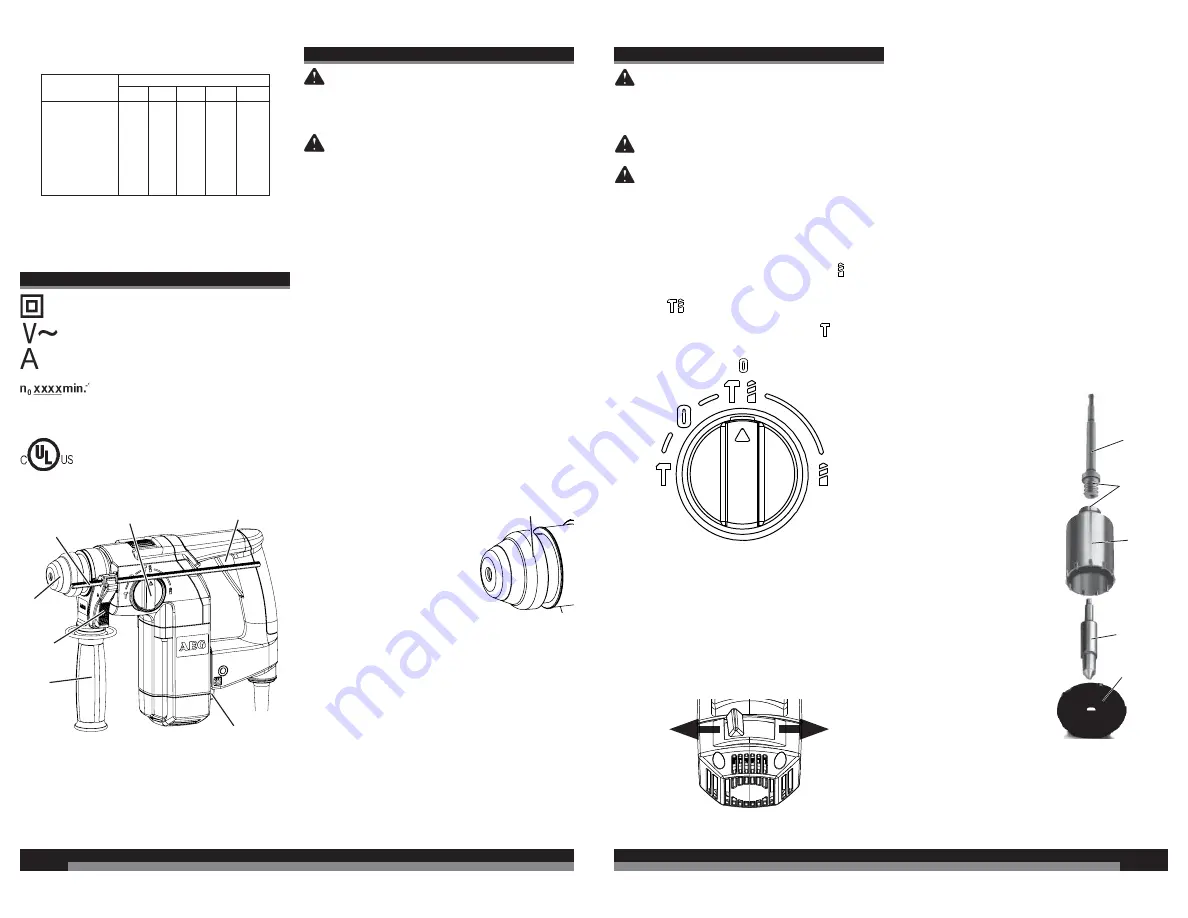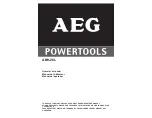
4
5
. . . . . . . . . Double Insulated
. . . . . . . Volts, Alternating Current
. . . . . . . . . . Amps
. . . No Load Revolutions per Minute
(RPM)
BPM
. . . . Blows per Minute (BPM)
. . . . . Underwriters Laboratories, Inc.,
United States and Canada
Recommended Minimum Wire Gauge
for Extension Cords*
Extension Cord Length
* Based on limiting the line voltage drop to
fi ve volts at 150% of the rated amperes.
Nameplate
Amperes
0 - 2.0
2.1 - 3.4
3.5 - 5.0
5.1 - 7.0
7.1 - 12.0
12.1 - 16.0
16.1 - 20.0
25'
18
18
18
18
16
14
12
75'
18
18
16
14
12
10
100'
18
16
14
12
10
150'
16
14
12
12
50'
18
18
18
16
14
12
10
READ AND SAVE ALL
INSTRUCTIONS FOR FUTURE USE.
SYMBOLS
ASSEMBLY
SDS+
bit holder
Mode selector lever
Trigger
Depth
gauge rod
Clamp
Side
handle
WARNING
To reduce the risk of injury,
always unplug tool before attaching or removing
accessories or making adjustments. Use only
specifi cally recommended accessories. Others
may be hazardous.
WARNING
To reduce the risk of injury,
always use a side handle when using this tool.
Always brace or hold securely.
Adjusting the Side Handle Position
1. Loosen the side handle by unscrewing the side
handle grip until the side handle rotates freely.
2. Rotate the side handle to the desired position.
3. Tighten the side handle grip securely.
Setting the Depth Gauge
1. Press in the clamping lever.
2. Slide the depth gauge rod backward or forward
until it is set for the desired depth.
NOTE:
The drilling depth is the distance between
the tip of the bit and the tip of the depth gauge
rod.
3. Release the clamping lever.
Installing Drill Bits and Chisels
NOTE:
Only use accessories with SDS or SDS
Plus shanks.
Be sure that the shank of the bit is clean. Dirt particles
may cause the bit to line up improperly. Do not use
bits larger than the maximum recommended capacity
of the drill because gear damage or motor overload-
ing may result. For best performance, be sure that
the bit is properly sharpened and the shank is lightly
greased before use.
1. Insert the bit or chisel into the nose of the tool.
2. Rotate bit slowly until it aligns
with the locking mechanism.
3. Push bit into tool until it
locks.
4. Check that the bit is locked
properly; it should be possible
to pull the bit back and forth
slightly (about 1/4”).
5. To remove bits and chisels,
pull bit holder release collar
toward the rear of tool and
remove bit.
NOTE:
Use caution when handling hot bits and
chisels.
Forward/Reverse
Control switch
Release
collar
OPERATION
WARNING
To reduce the risk of injury,
always unplug tool before attaching or removing
accessories or making adjustments. Use only
specifi cally recommended accessories. Others
may be hazardous.
WARNING
To reduce the risk of injury, wear
safety goggles or glasses with side shields.
WARNING
To reduce the risk of injury,
keep hands away from the bit and all moving
parts.
Selecting Action
This Rotary Hammer has three settings: drill only,
rotary hammer, and hammer only.
1. For drilling, turn the selector lever so the arrow on
the lever points to the twist drill symbol .
2. For rotary hammering, turn the selector lever so
the arrow points to the hammer and twist drill
symbol
.
3. For hammering only, turn the selector lever so the
arrow points to the hammer symbol
.
4. To freely rotate the bit to the desired angle for
chiseling only, turn the selector lever so the arrow
points to the symbol
. Then, follow step 3.
Starting, Stopping and Controlling Speed
1. To
start
the tool, grasp the handle fi rmly and pull
the trigger.
2. To
vary
the speed, increase or decrease the
pressure on the trigger. The further the trigger is
pulled, the greater the speed.
3. To
stop
the tool, release the trigger. Make sure
the tool comes to a complete stop before laying
the tool down.
Operating
Position the tool, grasp the handles fi rmly and pull
the trigger. Always hold the tool securely using both
handles to maintain control. This tool has been de-
signed to achieve top performance with only moder-
ate pressure. Let the tool do the work.
If the speed begins to drop off when drilling large
or deep holes, pull the bit partially out of the hole
while the tool is running to help clear dust. Do not
use water to settle the dust since it will clog the bit
fl utes and tend to make the bit bind in the hole. If the
bit should bind, a built-in, non-adjustable slip clutch
prevents the bit from turning. If this occurs, stop the
tool, free the bit and begin again.
Using Core Bits
Core bits are useful for drilling large holes for conduit
and pipe. They are specially designed for fast, ac-
curate drilling with combined hammering and rotary
action.
1. Clean and lubricate the
threads on the adapter
and core bit as indicated to
make later removal easier.
Screw the threaded end of
the adapter into the rear of
the core bit.
2. Push the guide plate onto
the pointed end of the
center pin. Insert the cen-
ter pin with guide plate
a ssembly into to the core
bit. Be sure the small end
of the center pin is se-
curely placed into the hole
in the center of the adapter.
3. Insert the adapter into the
bit holder of the tool as
described in “Inserting Drill
Bit or Chisel”. Set the rotary
hammer/drill lever to rotary
hammer.
4. Press the center pin fi rmly
against your center mark,
hold the tool fi rmly and pull
the trigger.
5. After drilling to about the
depth of the core bit teeth,
remove the center pin and
guide plate from the core bit. Resume drilling.
6. After you have fi nished drilling the hole, hold the
tool upwards, pointing it away from your body, and
run it briefl y in forward to loosen the core bit from
the adapter.
To make deeper holes, remove the bit, break and
remove the core. Resume drilling.
Adapter
Core Bit
Center Pin
Guide Plate
Clean and
lubricate
threads
Using the Control Switch
The control switch may be set to three positions: for-
ward, reverse and lock. Due to a lockout mechanism,
the control switch can only be adjusted when the trig-
ger is not pulled. Always allow the motor to come to a
complete stop before using the control switch.
For
forward
(clockwise) rotation, push the control
switch to the left side of the tool. Check the direction
of rotation before use.
For
reverse
(counterclockwise) rotation, push the
control switch to the right side of the tool. Check
direction of rotation before use.
Forward
Reverse























